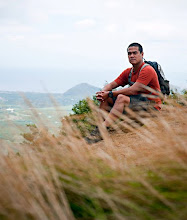I've never hiked with eighteen people before, but I did yesterday, including one dog. Chase set up an outing of epic proportions: eighteen people on a trail that they have never trekked (or even heard of) before, including Chase himself.
Upon arriving at the end of Wai'oma'o Street, my friend Kevin and I waited for Chase to grace us with his Filipino presence. To my amazement, a cavalry of cars and trucks loaded with people graced us instead, with Chase coming in with several of his friends in a truck. I thought a crew of no more than eight were going to be hiking to Ka'au Crater's waterfalls, but twenty people made me a little nervous because for one, the trail is closed, and two, the trail is on private land.
After everyone parked their vehicles, I found myself not knowing anyone but the feeling of awkwardness. Amongst the others, comfortable conversations led to hearty laughs and handshakes; even Levi the dog knew who everyone was. How 'bout an introduction Chase? Being the free-spirited Filipino he is, Chase eventually introduced me, giving me the title of "tour guide." Great, dude. Thanks for putting all the weight on my shoulders. I did spot a few people I knew, though, which made my feeling of awkwardness wane a little.
We set off around 9am. As soon as we started, a Board of Water Supply truck rolled up with three employees inside. They drove past our huge group with an astonished look like, "Holy shit, that's a lot of people!" I was apprehensive in proceeding down the stream, for I knew we would encounter the employees. I wondered if they would tell us to leave?
Fortunately, the three guys were cool and were just hiking to the stream gauging stations to get data to return to the lab. (What a job! I'd love to get paid for hiking.) They chatted with us a bit and told us about the pipe that is followed along the trail to the waterfall. They said that back in the old days, the pieces of pipe were carried by mules. Within the past five years, a new pipe was lain out and installed, and this time it was flown in by helicopters. Pretty interesting. I feel bad for those mules.
The trail was very muddy and slippery. I think everyone had their fair share of spills, some more than others, but after only half-an-hour of walking, we reached the first waterfall. The pool at the bottom of the waterfall looked the same as
the last time I hiked the trail: uninviting. I've seen pictures of people wading in the pool, but the water looks dark and brown. None of us took a dip.
The majority of our group made it to the first waterfall and turned around. Several of us climbed to the second waterfall. We took some individual and group shots, and I even had a beer from my friend Neil; he carried about ten Budweiser cans in a cooler in his backpack. I figured I'd have a beer to ease the weight from Neil's pack. He had a major hangover from the night before and still kept his buzz going by drinking on the trail. I think he puked twice, too. What a nut! After the beers, we headed back for the cars. Two adventurous girls decided to keep going to the crater rim by climbing the third waterfall. We wished them luck and parted ways.
Time was winding down, and I had to get to work by 12:30pm. Kevin and I caught up with the group that only went to the first waterfall. Their slow and careful pace prompted Kevin and I to overtake everyone. We reached my car a tad past 11am, and drive back home. Suprisingly, I made it to work exactly at 12:30pm.
Here's a list of my upcoming hike plans:
Thursday, 7/23 - Makapu'u--Tom-Tom
Sunday, 7/26 - Halawa Ridge?
Monday, 7/27 - Olomana
Wednesday, 7/29 - Kulepeamoa

First waterfall.

2nd waterfall.

Wai'oma'o Stream. (photo: C. Maglangit)

Crossing the stream with Levi the canine. (photo: C. Maglangit)

Kevin (in green) and one of the Board of Water Supply employees. (photo: C. Maglangit)

Looking down on the group from the top of the 1st waterfall. (photo: C. Maglangit)

Neil + hangover + more beers on the trail = a funny picture. (photo: C. Maglangit)

The group that made it to the 2nd waterfall. (photo: C. Maglangit)

























































